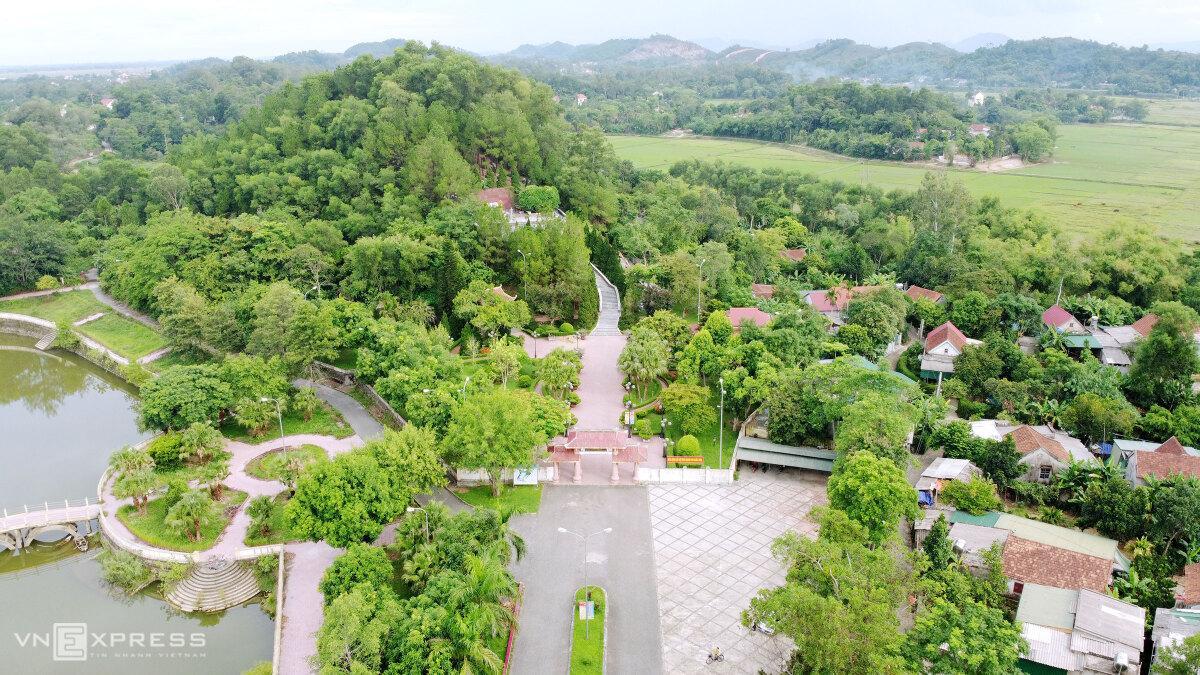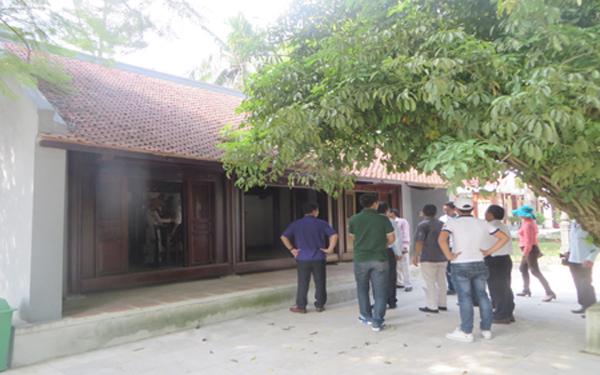WHERE IS THE REGULATION OF PRINCIPAL Secretary Tran Phu?
The relic site of the late General Secretary Tran Phu Along the wide National Highway 8A, the image of a quiet village with green rice fields on both sides of the road, about 18 km, we arrived at Tung Hinh commune. photo, Duc Tho district – the hometown of the late General Secretary Tran Phu. Comrade Tran Phu’s grave is located on Quan Hoi mountain, about 40 m2 wide, made of granite overlooking Tam Soa wharf (3 soft silks) is the confluence of 3 rivers:
Thousand Tuoi, Thousand Pho and Lam River are an image of the land spirit that gives birth to many masterpieces. Although I have read many articles about the extremely beautiful terrain of the historical site, which was inaugurated in 2004 on the occasion of the 100th birthday of comrade, in the newspapers, but come here to see the pictures of rivers and mountains. I really feel that I can gain the respect and sophisticated gratitude of the Party Committee and people of Ha Tinh province as well as the entire Vietnamese nation if it is with the merits of the great Communist.

MOVING TO THE RECEIVED REGULATION OF GENERAL SECURITY OFFICER TRAN PHU HA TINH PROVINCE
From Ha Tinh city, follow National Highway 1A to the North 30km to Hong Linh town, turn left along National Highway 8A 18km to Duc Tho town, continue 2km to Tran Phu relic area.
HISTORY OF THE REGULAR AREA OF GENERAL SECURITY OFFICER TRAN PHU HA TINH PROVINCE
The relic site of the late General Secretary Tran Phu The relic site of the late General Secretary Tran Phu was recognized as a national historical and cultural relic on June 11, 1992, but here, activities on conservation and preservation Keeping and promoting the value of the relic has a lot since 1977.
Initially, the relic was a nest belonging to Nghe Tinh museum, after Nghe Tinh was separated, the relic was managed by the Ha Tinh provincial museum. On June 14, 2002, the management board of Tran Phu relic was built. Since then, the relic has been under the direct management of the management board of the monument.
The minor branch church of the Tran family (2nd branch) was originally the house of equipment and people Tran Viet Tan – the great-grandfather of comrade Tran Phu – built in 1862. After Mr. Tan’s death, the house was inherited by Mr. Tran Viet Tien. . When Mr. Tien died, the house was inherited by Mr. Tran Van Pho – the father of Comrade Tran Phu. In the early spring of the new year 1901, when Mr. Pho brought his whole family to Tuy An district, Phu Yen province to teach, this house was used by Mr. Do Cau – Tran Phu’s biological uncle.
Until about the beginning of the new year 1930, when Mr. Do Cau bought a 3-room house next to it, this house was donated to his family by him and since then it has become a small church of the Tran family.

It was this house when comrade Tran Phu studied at Quoc Hoc Hue School (1918-1922) and when he taught at Cao Xuan Duc School in Vinh (1922-1925), he often visited home on special occasions. summer vacation, holiday. Therefore, the house was preserved and restored as a memorial monument to Tran Phu, a place to worship the spirits of Comrade Tran Phu and the spirits of ancestors of the Tran family.
The original church of the Tran family was originally built in the style of four pillars, 3 non-convex spaces, laterite walls around the base were assembled with stone blocks, and the roof was covered with marble tiles. The house was built in 1862, but due to the flood in 1945 and the first American war by air force (1964), the house has some changes but in general retains the architecture. Like the beginning.
In 1962, the house was renovated by Ha Tinh Cultural Company and purchased a 5-room dorm house as a display house to supplement and update artifacts and documents about comrade Tran Phu’s life and career to serve. visitors and research. In 1998, the Tran Phu memorial area was expanded and a new exhibition house was built.

WHAT’S HAPPENING WHAT’S HAPPENING TO THE REQUESTS OF GENERAL SECURITY Secretary TRAN PHU HA TINH?
The house displays more than 200 artifacts, memorabilia about the life and career of Comrade Tran Phu. We can see the genealogy of the Tran family from the 15th to the 18th generation on display here. Comrade Tran Phu’s father is Tran Van Pho, a native of Tung Image village, Duc Tho district, Ha Tinh province, and his mother is Mrs. Hoang Thi Cat, from Duong Chau commune, Nghi Loc district, Nghe An province.
However, Comrade Tran Phu was born in Tuy An palace, Phu Yen province – where his father was a teacher in 1904.
In the autumn of 1918, Comrade Tran Phu entered Quoc Hoc Hue School. During his study here, he sought out the old people, Phan Boi Chau, and Phan Chu Trinh, who are veterans of patriotic networking methods. In particular, he was taught by his teacher, Mr. Vo Liem Son, who directly aroused patriotism and national pride.

In September 1922, after passing the Thanh Chung exam, Tran Phu returned to teach at Cao Xuan Duc school in Vinh. During this time, he had the opportunity to get close to the working people and patriotic intellectuals, and was able to contact again. With patriotic newspapers such as “People in need” by Nguyen Ai Quoc, Tran Phu has actively participated in patriotic organizations such as Phuc Viet Association, Hung Nam Association. During this time, he often returned to his hometown to visit his hometown, while anonymously doing network activities.
In 1926, he was one of the members of the Hung Nam Association and went to Guangzhou to meet Nguyen Ai Quoc, attended a political training class, and joined the Vietnam Youth Union, founded by Nguyen Ai Quoc. .
In the early spring of the new year 1927, Tran Phu studied at the Oriental University in Moscow. Leader Nguyen Ai Quoc sent a letter to the school’s Party cell to introduce comrade Tran Phu as the secretary of the Vietnamese student group’s cell.
In 1928, he attended the 6th Communist International Congress.
In 1930, after graduating from Oriental University, he traveled from Moscow to Belgium, Germany, and France, then secretly returned to Saigon on February 8, 1930 with the knowledge of a theorist.
In July 1930, he was elected to the provisional Central Committee of the Party and was assigned to draft the political outline of the Party.

In October 1930, at the first meeting of the Central Committee of the Party, comrade presented the Political Thesis, which was unanimously discussed by the Conference. And you can observe that the political thesis drafted by comrade comrade in 1930, through so much rain and sun, is still fresh today.
At the age of 26, Comrade Tran Phu was first elected General Secretary of the Party, then went to Saigon to continue leading the network. In the midst of the rising trend, he was arrested, brutally tortured by the enemy, and his illness got worse, and he died at the age of 27 (in 1931).
Tran Phu sacrificed to leave a shining example of patriotism, infinite loyalty to the ideal of the network method, unyielding will, creative learning spirit, bright belief in the final victory.
Quan Hoi mountain belongs to Chau Linh village, Tung Image commune, Duc Tho district, is the burial place of Comrade Tran Phu with his father, mother, brother Tran Ngoc Danh of comrade Tran Phu. The method was nearly 80 years ago, at 8:00 am on September 6, 1931, Comrade Tran Phu breathed his last at Cho Quan hospital under the torture of the enemy’s whip. The French colonialists buried his body in the Catholic cemetery of Do Thanh, now Le Thi Rieng Park in District 10, Ho Chi Minh City.

Nearly 70 years away from the method after finding the remains of Comrade Tran Phu, at the Reunification Palace, Ho Chi Minh City, on the morning of January 12, 1999, the Party and State solemnly held a memorial ceremony and relocated the dead body. Comrade bones returned from Ho Chi Minh to be buried at home. On the afternoon of January 12, 1999, the remains of Comrade Tran Phu were brought to Vinh by plane, and brought back to his hometown, on this mountain, for burial.
Comrade Tran Phu Tomb Comrade Tran Phu ‘s grave is located on Quan Hoi mountain. In front is the Ngan Sau river and Tam Soa wharf flowing around like embracing the mountain, in the distance is the Thien Nhan range, the left and right sides are surrounded by mountains creating a very beautiful terrain.
Comrade’s grave was started construction on January 8, 2000 and has been completed in 3 stages so far, as you can see. The grave area has an area of about 7 hectares, of which 5 hectares is the hill and nearly 2 hectares is the lake area. Funding for construction was mobilized from the sources of the Central Secretariat of the Communist Party of Vietnam, the Central Administration and Finance Department and of Ha Tinh province.
The graves of two great-grandparents of Comrade Tran Phu, father Tran Van Pho and mother Hoang Thi Cat are also located on this campus. Their remains were found in Quang Ngai and interred in their hometown in 1999.
To the right of Quan Hoi mountain is the grave of Comrade Tran Ngoc Danh – the younger brother of Comrade Tran Phu, the 8th child in the household. Comrade Tran Ngoc Danh was a former member of the Central Committee of the Party, a member of the first National Assembly. He married Mrs. Thai Thi Lien and had two children, a son and a daughter. Comrade Tran Ngoc Danh’s remains were found in Na Coc village, Xuan Quang commune, Chiem Hoa district, Tuyen Quang province and brought back for burial in his hometown in 1999.
Source: Collected internet.